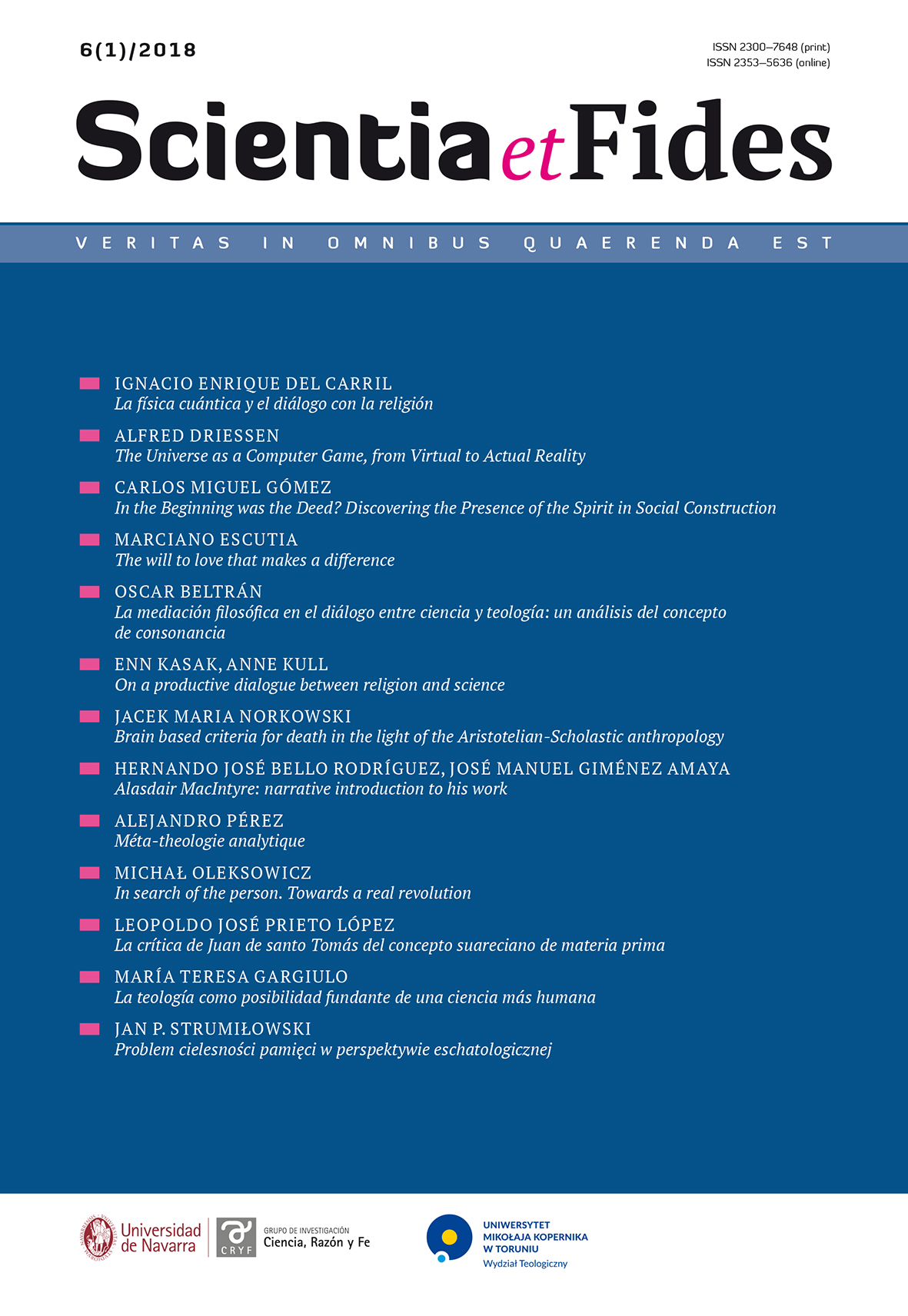La física cuántica y el diálogo con la religión
Parole chiave
Física cuántica, Ciencia y religión, Pascual Jordan, determinismo vs. Indeterminismo, realismo epistemológico, causalidad, doble negaciónAbstract
El presente trabajo tiene dos objetivos. En primer lugar, presentar a un autor poco conocido en los ámbitos filosóficos y científicos (aunque un poco más en estos últimos). Su nombre era Pascual Jordan (1902-1980) y participó en el nacimiento de la física cuántica en la primera mitad del siglo XX, trabajando codo a codo con Werner Heisenberg bajo la dirección de Max Born en la elaboración de la mecánica de matrices, aporte fundamental para precisar la estructura cuántica del átomo.
En segundo lugar, exponer su aporte personal a la cuestión acerca de las relaciones entre ciencia y religión. En ese sentido, Jordan se encuentra en una posición, por un lado, desfavorable, aunque, por otro, favorable para aportar a la cuestión. “Desfavorable”, porque Jordan es totalmente ajeno a cuestiones epistemológicas como lo es el debate sobre el realismo en la ciencia; y “favorable”, porque al tomarse seriamente los descubrimientos de la nueva física naciente, es un acérrimo realista en lo que respecta a las teorías científicas. Además, era un ferviente cristiano lo cual significaba que también era realista en materia de religión – inevitable actitud para quien considere que el binomio fe-vida sean inseparables. Su realismo constitutivo hace que las relaciones entre religión y ciencias sean para él un problema con tintes más existenciales que académicos; por eso, dedicó gran parte de su obra filosófica a responder esta cuestión.
Riferimenti bibliografici
Beyler, Richard Henry. 1994. From Positivism to Organicism: Pascual Jordan's interpretations of modern physics in cultural context. Tesis doctoral, Department of the History of Science, Harvard University, Cambridge, Massachusetts, Massachusetts: University Microfilms International, 585.
García Junceda, Antonio. 1985. "Dialécticos y Teólogos: ámbitos de suficiencia de la razón." Anales del Seminario de Historia de la Filosofía, 173-238.
Jordan, Pascual. 1978. Creación y misterio. Pamplona: Eunsa.
Jordan, Pascual. 1947. Die Physik und das Geheimnis des organischen Lebens. Fünfte Auflage. Braunschweig: Friedr. Vieweg & Sohn.
Jordan, Pascual. 1972. El hombre de ciencia ante el problema religioso. Translated by Daniel Romero. Madrid: Guadarrama.
Jordan, Pascual. 1953. La Física en el siglo XX. 2da ed. Translated by Eugenio Imaz. México: F.C.E.
La Mettrie, Julien Offray de. 1962. El hombre máquina. 2da edición. Translated by Ángel J. Capelletti. Buenos Aires: EUDEBA.
Laplace, Pierre-Simon. 1947. Ensayo filosófico sobre las probabilidades. Translated by Alfredo B. Besio and José Banfi. Buenos Aires: Espasa-Calpe.
Leibniz, Gottfried W. 1983. Nuevos ensayos sobre el entendimiento humano. 2da edición. Edited by J. Echeverría Ezponda. Madrid: Editora Nacional.
Popper, Karl R. 1967. Quantum Mechanics without "The Observer". Vol. II, chap. 1 in Quantum Theory and Reality, edited by Mario Bunge, 7-44. Berlin-Heidelberg-New York: Springer-Verlag.
Russell, Colin A. 2000. "The Conflict of Science and Religion." In The History of Science and Religion in the Western Tradition: An Encyclopedia, by AAVV, edited by Gary B. Ferngren, Edward J. Larson, Darrel W. Amundsen and Anne-Marie E. Nakhla, 12-17. New York & London: Garland Publishing, Inc.
Simard, Emile. 1961. Naturaleza y alcance del método científico. Translated by Salvador Caballero Sanchez. Madrid: Gredos.
Downloads
Pubblicato
Come citare
Fascicolo
Sezione
Licenza
CC BY ND 4.0. The Creator/Contributor is the Licensor, who grants the Licensee a non-exclusive license to use the Work on the fields indicated in the License Agreement.
- The Licensor grants the Licensee a non-exclusive license to use the Work/related rights item specified in § 1 within the following fields: a) recording of Work/related rights item; b) reproduction (multiplication) of Work/related rights item in print and digital technology (e-book, audiobook); c) placing the copies of the multiplied Work/related rights item on the market; d) entering the Work/related rights item to computer memory; e) distribution of the work in electronic version in the open access form on the basis of Creative Commons license (CC BY-ND 3.0) via the digital platform of the Nicolaus Copernicus University Press and file repository of the Nicolaus Copernicus University.
- Usage of the recorded Work by the Licensee within the above fields is not restricted by time, numbers or territory.
- The Licensor grants the license for the Work/related rights item to the Licensee free of charge and for an unspecified period of time.
FULL TEXT License Agreement
Stats
Number of views and downloads: 1098
Number of citations: 1



